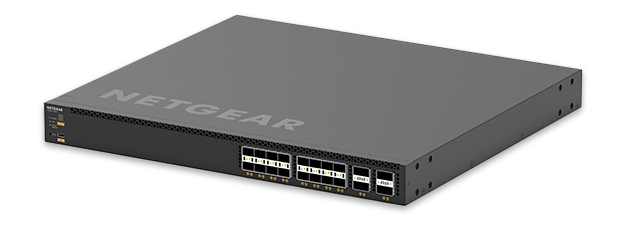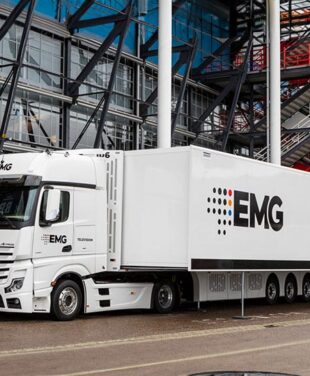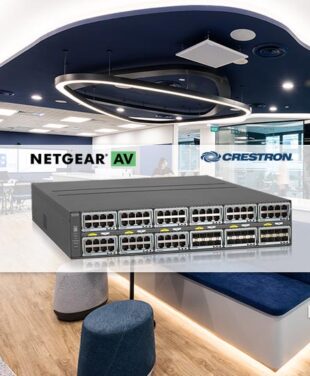IN THIS ARTICLE

When many people think of live sports in Japan, they think of major sports such as baseball, soccer, golf, and Ekiden (Japanese long-distance relay race) broadcast by TV stations. Now, however, a variety of sports competitions can be viewed live online, thanks to Osaka-based RTV. In addition to live streaming production, the company’s wide-ranging work includes video distribution consulting, distribution media management, and human resource development.
In 2023, RTV built a control room for remote production, centered on Panasonic Connect’s KAIROS IP production switcher, at its headquarters in Osaka. NETGEAR’s fully managed M4350- 16V4C switch has been chosen to handle the SMPTE ST 2110 and other signals ensuring the precision timing is maintained.
We asked Sota Suzawa, president of RTV, about the benefits of NETGEAR products and the current state and future vision of AV over IP in online live streaming.
WHAT RTV IS AIMING FOR IN THE MIDST OF MANY PROTOCOLS
NETGEAR: Please tell us about the work of RTV.
Susawa: We operate professional streaming services for American football and lacrosse with our federations and associations. In addition, we operate a sports streaming media company, not broadcast on terrestrial waves, and a live streaming service for bus fishing (a Japanese type of fishing).
Through these activities, we aim to fuse live-streaming technology and other ideas to create new fans of minor league and local sports.
N: The RTV system brings out the best of AV over IP in a compact size. What are some of the things you have learned?
S: We are working on smart production and remote production separately. Smart production uses Vizrt (formerly NewTek) TriCaster and BlackMagic Design equipment. It is cheaper than broadcasting equipment, but our strength is that we can use them to create high-quality images.
In 2023, we also set up a remote production system and asked a system integrator, Aschirak, to build a subsystem centered on KAIROS.
There are two objectives. One is to increase the number of deliveries. I feel that the usability of the distribution of minor and local sports is higher if it is delivered as much as possible at a low price while maintaining a certain level of quality, rather than producing each one at a high quality like television broadcasting.
The other is changing needs. In the past, there were many live streaming services such as “let’s stream it on YouTube for the time being”, but the demand for monetization has increased. Under these circumstances, it has become necessary to have a system that can concentrate on the stability of distribution and troubleshooting. We have built a control room with these in mind.
N: Do you mean that remote production has a unique advantage over on-site production?
S: Golf delivery, for example, is very expensive. Amateur, elementary, and junior high school golf tournaments do not have many spectators, but there is still a need for content. To meet these needs, we use a variety of smaller control rooms to create content for about one-fifth the cost of regular TV broadcasts.
The most significant advantage of IP is that the system can be expanded within the control room. In recent years, transmitting high-quality video over existing internet lines has become possible without using dark fiber. I wanted to build a system that could produce them remotely using inexpensive encoders.
N: NETGEAR switches now handle the ST 2110 connection while also dealing with other transmission protocols. How do you see the benefits of using ST 2110?
S: RTV uses two KAIROS systems. When the number of inputs and outputs needs to be increased according to the site requirements, ST 2110 can be multicast without using an SDI distributor, making it easier to route and distribute. In the future, we would like to build another system that can be used with ST 2110, including the voice system

THE M4350-16V4C WAS INEVITABLE
N: Why did you choose the NETGEAR M4350-16V4C switch for the ST 2110 signals?
S: Products for the ST 2110 have been very expensive. Considering the balance between quality and cost, we felt that the M4350- 16V4C was cost effective.
Originally, RTV had a NETGEAR AV switch. Its UI is also very easy to understand. While some switches can only be configured with a network engineer, NETGEAR AV switches include presets which are designed to operate efficiently. It has been very helpful for us as we are on the delicate line between the video and internet industries.
We felt that the products of the major network equipment manufacturers were over-specified. NETGEAR products provide a good balance of performance and cost when building a small or medium-sized facility.
So, RTV’s most important goal is to create a system that can be used in a variety of situations while keeping prices low. In that sense, the NETGEAR switch was a good choice. When there is something you want to do, you can do it as soon as you think of it without spending time changing settings.

HOW TO PURSUE REMOTE PRODUCTION
N: How do you think remote production systems will evolve in the future?
S: In the current remote production, the image is that the camera is operated remotely on the road. From now on, video production, live streaming, and broadcast video production that does not depend on dedicated sites will become mainstream. In the future, it is possible to create broadcast control rooms in rural areas or collaborate with various businesses. Usually, it is necessary to go to the site by relay vehicle, but if it is connected by IP, it should be possible to hand over various projects at each site simultaneously. In the future, live announcers and commentators can also appear from home. I would also like to promote this new way of working.
N: That kind of cooperation is being actively promoted in Europe and elsewhere, but there are areas where concrete benefits have yet to be seen in Japan. What do you think about that?
S: When broadcasters and production companies are doing broadcasts on a large scale, they think it would be safer to go to the site. However, our focus area is to convert small-scale event content into streaming video content.
On that scale, you could send the video from home on a PC and ask the director to switch it back. If this is achieved, video production with higher cost performance will become possible. We are in the process of conducting a trial to realize such an environment.
In the future, we would like to split up the remote production control room bases, such as “slow-mo at this base” and “CG over there”. We handle commentary at a separate site. We record commentary at the Tokyo office and switch and telop at the Osaka office.
The video technician must adjust the network settings if the work sites are separated. The point is whether we can do it within the scope of our knowledge. I think so. When choosing equipment for separate locations, it is crucial to ensure that the manufacturer thoroughly verifies the function aspects and settings. As with the NETGEAR Pro AV and ST 2110 switches, the equipment must be easy to operate and accessible. This should make it easier to deploy new systems and services.
N: Finally, please tell us about your vision as RTV.
S: Again, our vision is to disseminate events that may not be the most popular in the world and become a video distribution business so that fans can feel the value. This applies not only to sports but also to all projects that we work on with companies and local governments.
To make your vision a reality, you must make your live stream production more uncomplicated and efficient. Technically, I want to establish a way to create more exciting videos while searching for ways that do not rely on always being on-site.
SUMMARY
The method of bringing together resources and connecting them via the Internet to create one extensive system is already at a practical level for European broadcasters. On the other hand, in Japan, where Internet broadcasting is growing, there is a strong need for a system that allows small- and medium-sized businesses to collaborate.
It’s impractical for a video technician to ask a system integrator to set up a simple system. Even if you build it yourself, if a problem occurs, it is difficult for video technicians to solve it alone. It is reassuring that NETGEAR AV switches have many pre tested presets available.
In AV over IP, the network switch is the undercarriage and never stands out. However, it will result in significant problems if it is not solid. With the expansion of remote production, NETGEAR AV switches are fast becoming “standard equipment”.
Find out More
Find out more about our broadcasting solutions and the NETGEAR AV LINE M4350 switches supporting SMPTE ST 2110.




